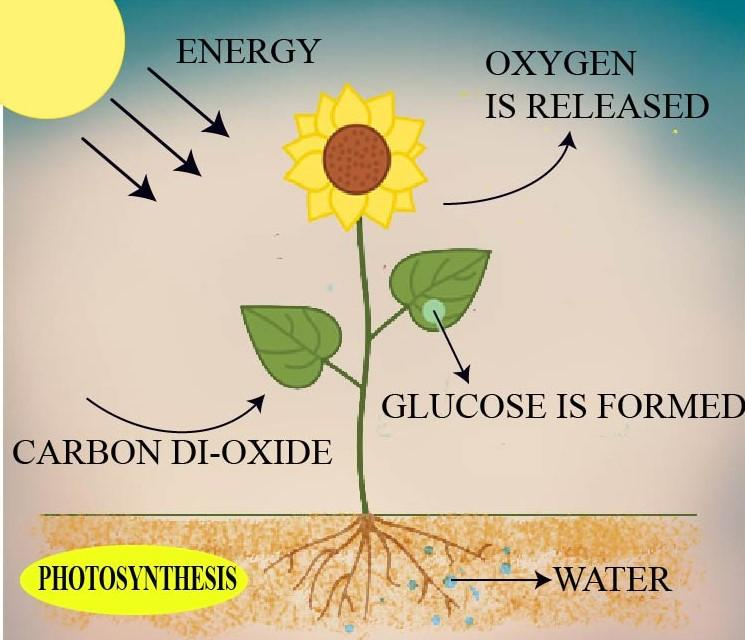
The autotrophic mode of nutrition requires
(a)Carbon dioxide
(b)Chlorophyll
(c)Sunlight
(d)All of the above
Answer
518.1k+ views
Hint:The autotrophic mode of nutrition refers to the formation of one's own food with the help of inorganic sources of energy. The plants contain membrane-bound organelles known as chloroplasts. They consist of a stack of membranous cells called grana. Each cell of a granum is called a thylakoid that contains the chlorophyll molecules.
Complete answer:
Photosynthesis is the natural process of conversion of solar energy into chemical energy. It results in the formation of organic compounds like carbohydrates. Plants synthesize their own food with the help of carbon dioxide, chlorophyll, water, and sunlight.
-It is mainly responsible for the formation of oxygen that sustains all life forms on the earth.
-Different types of pigments present in plants are chlorophyll a, b, c, d, xanthophylls, and carotenoid.
-Chlorophyll ‘a' forms the reaction center in the plastids and is the primary chlorophyll pigment, rest all are accessory pigments.
-Chlorophyll ‘b’ is responsible for absorbing the sunlight and passing it to the reaction center.
-The process can be differentiated into two phases- Light-dependent reactions and Light independent reactions.
-The light reaction involves the photolysis of water. The sunlight breaks the water molecule into hydrogen, oxygen, and electrons. The hydrogen and electrons produced are used to produce NADPH from NADP and ATP from ADP.
-The NADPH and ATP are then transferred to the Light independent reactions that include conversion of carbon dioxide into organic compounds like sugars.
So, the correct answer is ‘All of the above'.
Note:
-Photosynthesis was first observed in the blue-green algae or cyanobacteria. It consists of chlorophyll a, b, and carotenoids.
-A plant cell consists of 10-100 chloroplast cells.
-Chlorophyll a is present in all photosynthesizing organisms Chlorophyll b is present in higher plants, pteridophytes, bryophytes, and blue-green algae. Chlorophyll c and d are found in brown algae; diatoms and red algae respectively. Whereas, Chlorophyll e is present in the algae of class Xanthophyceae such as Vaucheria and Botrydium.

Complete answer:
Photosynthesis is the natural process of conversion of solar energy into chemical energy. It results in the formation of organic compounds like carbohydrates. Plants synthesize their own food with the help of carbon dioxide, chlorophyll, water, and sunlight.
-It is mainly responsible for the formation of oxygen that sustains all life forms on the earth.
-Different types of pigments present in plants are chlorophyll a, b, c, d, xanthophylls, and carotenoid.
-Chlorophyll ‘a' forms the reaction center in the plastids and is the primary chlorophyll pigment, rest all are accessory pigments.
-Chlorophyll ‘b’ is responsible for absorbing the sunlight and passing it to the reaction center.
-The process can be differentiated into two phases- Light-dependent reactions and Light independent reactions.
-The light reaction involves the photolysis of water. The sunlight breaks the water molecule into hydrogen, oxygen, and electrons. The hydrogen and electrons produced are used to produce NADPH from NADP and ATP from ADP.
-The NADPH and ATP are then transferred to the Light independent reactions that include conversion of carbon dioxide into organic compounds like sugars.
So, the correct answer is ‘All of the above'.
Note:
-Photosynthesis was first observed in the blue-green algae or cyanobacteria. It consists of chlorophyll a, b, and carotenoids.
-A plant cell consists of 10-100 chloroplast cells.
-Chlorophyll a is present in all photosynthesizing organisms Chlorophyll b is present in higher plants, pteridophytes, bryophytes, and blue-green algae. Chlorophyll c and d are found in brown algae; diatoms and red algae respectively. Whereas, Chlorophyll e is present in the algae of class Xanthophyceae such as Vaucheria and Botrydium.

Recently Updated Pages
Master Class 11 Business Studies: Engaging Questions & Answers for Success

Master Class 11 Economics: Engaging Questions & Answers for Success

Master Class 11 Accountancy: Engaging Questions & Answers for Success

Master Class 11 Computer Science: Engaging Questions & Answers for Success

Master Class 11 English: Engaging Questions & Answers for Success

Master Class 11 Maths: Engaging Questions & Answers for Success

Trending doubts
Which one is a true fish A Jellyfish B Starfish C Dogfish class 11 biology CBSE

Difference Between Prokaryotic Cells and Eukaryotic Cells

1 ton equals to A 100 kg B 1000 kg C 10 kg D 10000 class 11 physics CBSE

1 Quintal is equal to a 110 kg b 10 kg c 100kg d 1000 class 11 physics CBSE

One Metric ton is equal to kg A 10000 B 1000 C 100 class 11 physics CBSE

How much is 23 kg in pounds class 11 chemistry CBSE




